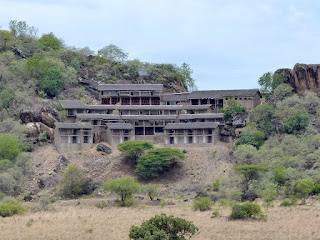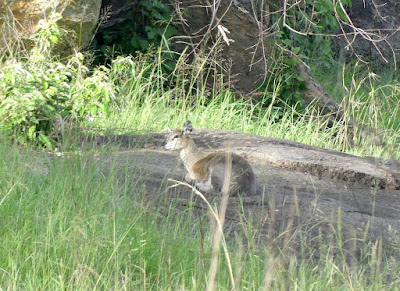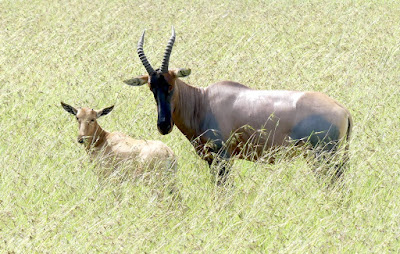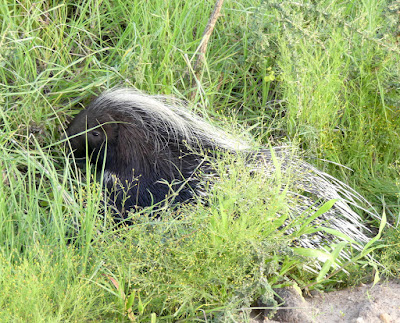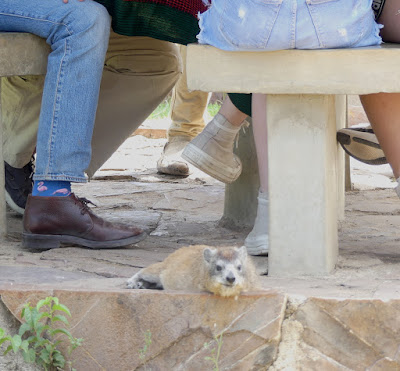On Tuesday 7th January we left Speke Bay Lodge and Lake Victoria and re-entered Serengeti NP at the Ndabaka Gate. It was a relatively short drove to our next overnight stop - Mbalageti Lodge. On the way to the lodge we spied small numbers of Wildebeest and Zebra but not yet the large migration herds we were hoping for. We saw over 50 species of birds including Silverbird, Steel-blue Whydah, Black-winged Kite, Grey Kestrel, Dwarf Bittern, Pygmy Falcon and Grey-breasted Spurfowl. Some large crocodiles were loafing on the bank of the fast-flowing Grumeti River.
 |
| Yellow-throated Longclaw. |
 |
| Grey-breasted Spurfowl. |
 |
| Nile Crocodile. |
 |
| Wildebeest with Western Cattle Egrets (and a Zebra). |
Mbalageti Lodge was high on a hilltop with spectacular views over the plains. To reach it we had to leave our car on one side of the Mbalageti River and get taken across in one of the lodge vehicles as the river was deemed to be running too high for clients to cross by themselves. For once we had plenty of time once at the lodge for swimming and birding in the afternoon.
 |
| Changing vehicles for the river crossing. |
 |
| Sensational view from the bar area. |
 |
| Martial Eagle over the bar. |
 |
| Black-headed Oriole. |
Next morning we headed off to the eastern side of the park and our beds for the night in Kananga Tented Camp. This was a long day and we spent quite a bit of time looking unsuccessfully for a Karamoja Apalis, a small grey bird with white wing patches that is occasionally found in areas of Whistling Thorn Acacia. Over 90 bird species today with the highlights being: Eurasian Hobby, Black Coucal, Lizard Buzzard, European Bee-eater, Pallid Harrier, African Crake, White-headed Saw-wing, Chestnut Weaver, Rosy-throated Longclaw, Tanzanian Red-billed Hornbill and Abyssinian Scimitarbill.
 |
| Rosy-throated Longclaw. |
 |
| African Crake. |
 |
| Yellow-winged Bat. |
 |
| Silverbird. |
 |
| Bat-eared Fox. |
 |
| Kirk's Dikdik. |
 |
| Black-backed Jackal. |
 |
| Zebra and Common Ostrich. |
Kananga Tented Camp is a series of tents on the edge of a treeless grass plain. The grass was about a meter high except immediately around the tents where it had been slashed. The lions that we were told were lurking close by apparently know not to enter the slashed area. We had this camp to ourselves.
 |
| Kananga Tented Camp with the lion-proof grass slashing. |
Next morning we left before dawn and soon came across a group of lion cubs. There were three half-grown ones and four quite small ones. We found their mothers a km or two away where they had presumably been hunting in the night.
 |
| Lion struggling to stay awake. |
 |
| Lou shooing a Superb Starling that kept coming too close for Rob to photograph. |
 |
| Superb Starling. |
 |
| Hartlaub's Bustard. |
We drove to the Naabi Hill gate and exited the park there into the adjacent Ngorongoro Wildlife Management Area. Along the way we finally caught up with migration and were treated to Wildebeest and Zebra herds from horizon to horizon. Another long day saw us reach Rhino Lodge just before dusk. An astonishing 120 species of birds were recorded that day. Highlights were many: Cape Crow, African Stonechat, Greater Kestrel, Rüppell's Vulture, Speke's Weaver, White-bellied Bustard, White Stork, Tree Pipit, Lesser Kestrel, Amur Falcon, Common Rock Thrush and Black Saw-wing.
 |
| Rüppell's and White-backed Vultures and a Marabou Stork on a Zebra carcase. |
 |
| Thompson's Gazelle. |
 |
| Secretarybird |
 |
| Lappet-faced Vulture. |
 |
| Black-winged Stilt. |
Rhino Lodge was the first busy lodge we had stayed in. It is situated on the Ngorongoro Crater rim at 2,270 m (about 20 m higher than the highest point in Australia - Mount Kosciuszko) and it was quite chilly. The rooms had fireplaces and hot water bottles available.
Next morning we were on the road before dawn (again) for the drive down into the crater. Stanley said "watch for lions" as he pulled out onto the sealed road. This is a populated area with people, farms, cattle etc. We had only gone a km or two when a male lion walked across the road in front of us and disappeared into the bushes. The drive down the the crater floor (at 1750 m) was very steep and a bit scary in the semi-darkness. The crater was marvellous with animals everywhere you looked. We saw Golden Jackals, many Lions, several Rhinoceros, a couple of Eland, Thompson's and Grant's Gazelles as well as the usual Wildebeest, Zebra, Elephants and Buffalo.
 |
| Eland. |
 |
| Golden Jackal. |
 |
| Cape Buffalo. |
 |
| Lion. |
 |
| Black Rhinoceros |
Birds were plentiful and we saw over 70 species including Anteater Chat, Caspian Plover, Black-winged Lapwing, Abyssinian Thrush, Abdim's Stork, Grey Crowned Crane, Lanner Falcon, Cinnamon-chested Bee-eater, Abyssinian Wheatear and Great White Pelican.
 |
| Black-winged Lapwing. |
 |
| Pin-tailed Whydah. |
 |
| Ngorongoro Crater. |
Our last night was spent in the quite busy Eileen's Trees Hotel in bustling Karatu. Back in civilisation! Our safari was a long time in the planning and anticipation and then it went so quickly. We collected the Rav from African Safari Glamping lodge where we had left it ten days earlier, farewelled Stanley and his trusty safari vehicle, fixed a flat tyre in Mto Wa Mbu and drove home without further incident.
Total bird count was 328 species with 11 lifers for me - several new mammals as well.









































